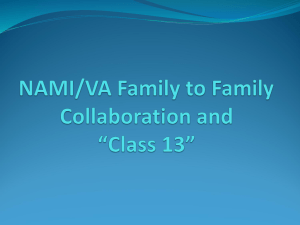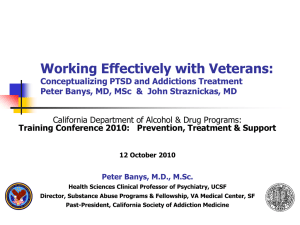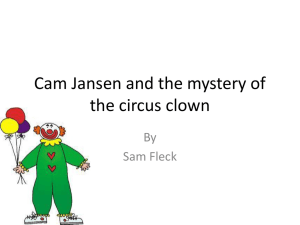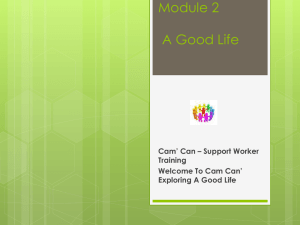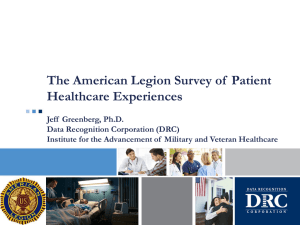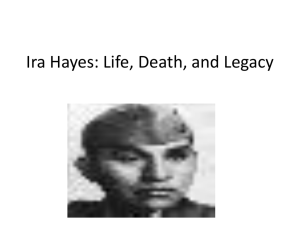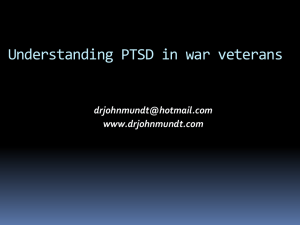Dr. Jennifer Strauss, Department of Veterans Affairs
advertisement
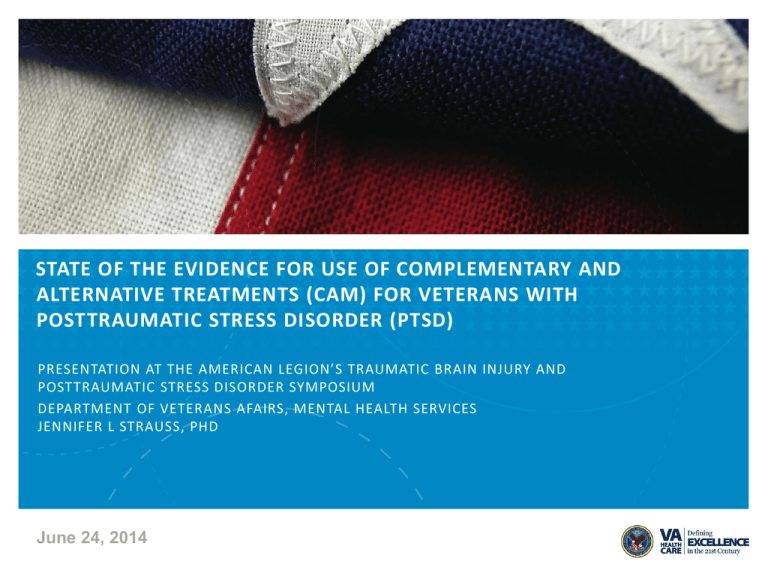
STATE OF THE EVIDENCE FOR USE OF COMPLEMENTARY AND ALTERNATIVE TREATMENTS (CAM) FOR VETERANS WITH POSTTRAUMATIC STRESS DISORDER (PTSD) PRESENTATION AT THE AMERICAN LEGION’S TRAUMATIC BRAIN INJURY AND POSTTRAUMATIC STRESS DISORDER SYMPOSIUM DEPARTMENT OF VETERANS AFAIRS, MENTAL HEALTH SERVICES JENNIFER L STRAUSS, PHD June 24, 2014 Overview This brief presentation will: • Review definition of terms (e.g., what is CAM?) • Summarize findings from recent VA reviews of studies that have evaluated applications of CAM for PTSD • Summarize conclusions and recommendations derived from those reviews VETERANS HEALTH ADMINISTRATION 2 Recent Reviews of the Evidence for Use of CAM for PTSD • Systematic evidence review: – Strauss, JL et al. (2011). Efficacy of Complementary and Alternative Medicine Therapies for Posttraumatic Stress Disorder, VA Evidence-based Synthesis Program (ESP) Center, VA-ESP Project #09-010. – http://www.hsrd.research.va.gov/publications/esp/cam-ptsd.cfm • Review article: – Strauss, JL & Lang, AJ (2012) Complementary and Alternative Treatments for PTSD, PTSD Research Quarterly, 23 (2), National Center for PTSD. – Distributed electronically to 17,000 – Since April 2013, ~8 views/week; downloaded ~ 500 times – http://www.ptsd.va.gov/professional/newsletters/research-quarterly/v23n2.pdf VETERANS HEALTH ADMINISTRATION 3 Recent Summaries of the Evidence for Use of CAM for PTSD • Provider fact sheet: – Strauss, JL, Lang, AJ, & Schnurr, PP (2014) Complementary and Alternative Medicine (CAM) for PTSD, National Center for PTSD. – Since May 20th, ~20 views/week; average time on page >8 minutes – http://www.ptsd.va.gov/professional/treatment/overview/complementary_alternative_ for_ptsd.asp • Consumer fact sheet: – Under development: will be available on the VA National Center for PTSD website VETERANS HEALTH ADMINISTRATION 4 What is CAM? • Complementary and alternative medicine (CAM) includes a range of therapies not considered standard to Western (US) medicine. • Complementary: use of these techniques in combination with conventional approaches • Alternative: use of these techniques in lieu of conventional approaches • Many treatments considered to be CAM in the US are considered conventional approaches in other parts of the world (e.g., acupuncture) • Line between CAM and conventional changes over time – Example: relaxation training (including CAM techniques) is a standard component of many conventional PTSD therapies – Example: biofeedback commonly used to treat pain management skills VETERANS HEALTH ADMINISTRATION 5 What is CAM? • CAM is an umbrella term that describes a wide range of modalities • • • • • • • • • • Acupuncture/acupressure Biofeedback/neurofeedback Deep breathing Energy therapies Guided imagery Healing touch Homeopathy/herbal remedies Hypnosis Light therapy Massage VETERANS HEALTH ADMINISTRATION • • • • • • • • • • Meditation Mindfulness-Based Stress Reduction Neuro-linguistic programming Progressive relaxation Qigong/tai chi Reiki energy healing Spinal manipulation Traditional Chinese Medicine Yoga More… 6 State of the Evidence • Current evidence base is very limited (but growing) • 2011 evidence review included 7 randomized controlled trials, most of poor/fair quality: – – – – 1 acupuncture (1 good quality) 3 relaxation (3 poor quality) 2 meditation (1 fair, 1 poor quality) 1 massage (1 poor quality) • Insufficient evidence to draw strong conclusions about the efficacy • Insufficient evidence to describe other important components of treatment decision-making: safety, cost effectiveness, dosing, indications and contraindications, mechanisms of action, etc. • Retention rates, when reported, similar to evidence-based approaches VETERANS HEALTH ADMINISTRATION 7 State of the Evidence • Highest quality evidence exists for acupuncture • Acupuncture > wait list control • Acupuncture ≐ active treatment (group CBT vs individual CBT?) • Strong conclusions cannot be reliably drawn on the basis of a single RCT (further study needed) • Greatest breadth of evidence exists for relaxation • Findings mixed: some studies show modest effect, others show no effect relative to active comparators • Most studies small with significant design flaws that limit interpretability VETERANS HEALTH ADMINISTRATION 8 State of the Evidence • Evidence in support of meditation as adjunctive treatment generally positive • Meditation > control (usual care) • Usual care + meditation > usual care alone • Meditation vs. active treatment ? • Different types of meditation with different hypothesized mechanisms of action (further study needed) VETERANS HEALTH ADMINISTRATION 9 Summary and Conclusions • The umbrella of CAM approaches includes a broad range of approaches, not all of which may hold the same level of promise for PTSD • Preliminary findings are mixed, but suggest that CAM therapies merit consideration and further research • Current evidence does not support the use of CAM interventions as alternatives to current empirically-supported PTSD approaches or as 1st line approaches • Current evidence points to possible use of CAM interventions as adjunctive interventions VETERANS HEALTH ADMINISTRATION 10
